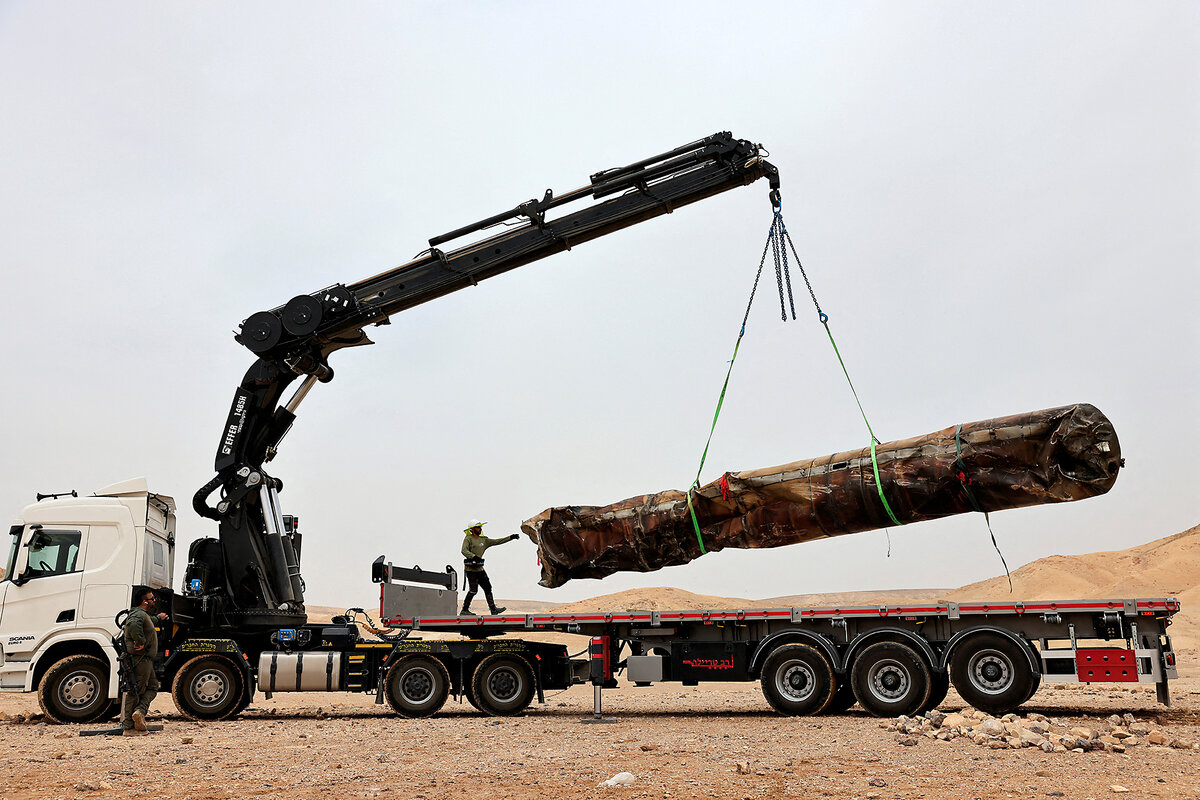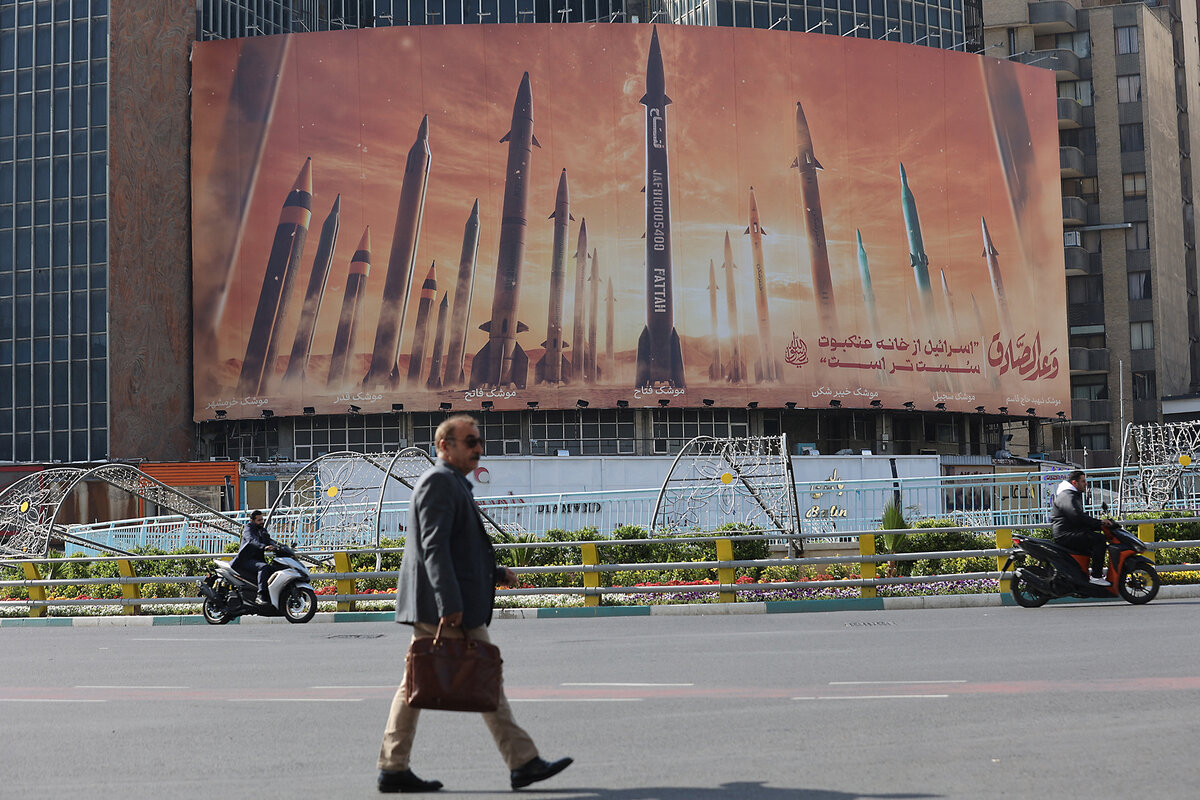Strike, counterstrike: What Israel just learned about Iran’s red lines
Loading...
| London
For Israel’s targeting officers, it was just another day at the office.
As they had done scores of times in recent years, with little discernible pushback from Iran, the Israelis ordered a targeted assassination against enemy personnel abroad.
In this case, it was a strike April 1 in Damascus, Syria, which killed several senior Islamic Revolutionary Guard Corps generals who were key to running Iran’s regional “Axis of Resistance” operations against Israel.
Why We Wrote This
In war, outdated assessments and untested assumptions about one’s adversary can lead to hazardous miscalculations. The brief but violent exchange between Israel and Iran put the region and world on edge before calm was restored.
But that strike destroyed an Iranian consular building, and so triggered an unexpected and unprecedented response from Tehran two weeks later – a barrage of more than 300 missiles and drones, launched directly from Iranian soil at Israel, the scale of which by all accounts took the Israelis by surprise.
Nearly all the projectiles were shot down April 14 by Israel, as well as the United States and Jordan. And Israel’s own limited response, reportedly taking out an Iranian air defense system in central Iran April 19, ended the latest escalatory spiral.
But Israel’s first-ever direct kinetic exchange with Iran has yielded lessons for Israel, analysts say, even as the Jewish state simultaneously wages war in Gaza – sparked by Iran’s “Axis” ally Hamas’ invasion of Israel last Oct. 7 – and faces a much more formidable Iran-backed enemy in Lebanon, Hezbollah.
“We got used to the fact that, if Iran wants to carry out an attack against Israel, it would either be through the use of proxies, or through Syria, or through terrorist attack,” says Raz Zimmt, an Iran expert at The Institute for National Security Studies and The Alliance Center for Iranian Studies at Tel Aviv University.
For years, he says, Israel assumed that only one scenario – an attack by Israel on Iranian nuclear facilities – would spark a direct Iranian retaliation. And since Oct. 7, even though Iran-backed militias from Yemen to Iraq, Syria, and Lebanon have increased exchanges with Israel, Iran made clear it did not want a wider war.
“For the first time we see another possibility coming from Iran,” says Dr. Zimmt, a former adviser on Iran to the Israel Defense Forces.
Khamenei’s leadership
Iran’s unprecedented reaction is also causing a reevaluation of the “willingness to take risks” by Iran’s leadership, helmed by supreme leader Ayatollah Ali Khamenei.
“We have to reconsider whether Khamenei – especially today, as he ages, is perhaps getting weaker, is perhaps surrounded by more hard-liners, is thinking more and more about his legacy – is the same cautious leader we used to know for decades,” adds Dr. Zimmt.
If Mr. Khamenei, he says, “was ready to take this risk, by launching more than 300 missiles and drones, which is certainly not a symbolic reaction,” then Israelis are now bearing in mind “whether we should expect that in other areas, for example the nuclear strategy of Iran.”
Iran’s April barrage “doesn’t necessarily mean that Iran is going to be a different country from now on, that Khamenei is going to be a different kind of leader from now on,” Dr. Zimmt adds. “But it’s certainly added some doubts about the strategies and policies of Iran as we knew them, until now.”
Taking fully eight days before commenting on Iran’s strike, which some critics derided as a “failure” for its lack of impact in Israel, Mr. Khamenei praised Iran’s military forces for mounting a barrage that “infuriated” Israel and its allies, and encouraged commanders to “learn from the enemy.”
The Iranian strike – which included the largest single drone attack in history – came after months in which Iran appeared to take little direct action to repulse an increasingly brazen Israeli campaign of targeting Iranian and “Axis” assets across the region.
While Iranian hard-liners complained noisily about Iran’s toothless reaction until mid-April, it was similar muted Iranian reactions that appear to have lulled Israeli forces into a sense of complacency about the cumulative impact of their targeted assassinations.
“Israel has operated with a lot of freedom in Syria for a long time, and it’s done similar acts before, but of course this one is very different because it was in a consular compound,” says Mairav Zonszein, the senior analyst for Israel of the International Crisis Group. “So there was clearly a failure of intelligence and of the political echelon to understand the ramifications of that move.”
Israel now “understands much more clearly” that striking anything that Iran considers Iranian territory is a “red line,” which is likely to be taken into account by Israel “next time,” she says.
Iran’s strike itself was also “far greater in scope than [Israeli officials] anticipated, the numbers and munitions used,” says Ms. Zonszein. “Everybody is learning from that situation – what the ability of Iran is to attack, what the ability of Israel and some of its allies is to defend.”
Nuclear threat is main concern
Still, she says that bigger questions remain about “how Israel is going to recalibrate itself toward Iran” and its allies – especially Hezbollah.
On top of that, despite Iran’s conventional weapons barrage, “the major concern for Israel [on Iran] is the nuclear threat,” says Ms. Zonszein. “And the major threat that is not nuclear is from Hezbollah in Lebanon, because they have very high numbers of missiles and rockets, some of them precision-guided, and they live next door.”
Indeed, Iranian officials and pundits have reveled in Iran’s hand in creating the strategic dilemmas faced by Israel, especially since Oct. 7, when the Hamas attack from Gaza into Israel left 1,200 dead, 250 people taken hostage, and a nation still coping with trauma. Israel’s military response in Gaza has yet to destroy Hamas or its leadership – two key war aims – but it has left more than 34,000 Palestinians dead and swaths of the enclave reduced to rubble.
Soon after the Iranian attack – which Iran claims to have resulted in a “new order” in the region – the hard-line Iranian newspaper Vatan-e Emrouz published a front-page photograph of Israeli Prime Minister Benjamin Netanyahu praying at the Western Wall in Jerusalem, with the one-word headline, “Desperate.”
“At the end of the day, I don’t think Israel would refrain from attacking Iranian assets in Syria, or anywhere else,” though it is likely to refrain from targeting diplomatic compounds and overtly targeting Iranians inside Iran, to avoid triggering a similar Iranian barrage, says Dr. Zimmt at The Institute for National Security Studies.
“This will certainly play a role in future Israeli decisions, but not to the point that Israel will not do that anymore,” he says.








